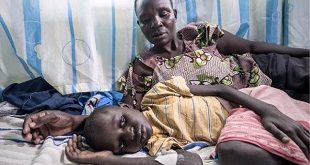
There was no patient being treated, but Kanyike said the 7000kg machine that works 24/7 from Monday to Friday can handle 80 patients per day. Just like Atiang, Kanyike also sounded excited about the new machine, describing it fondly as “a machine that has everything modern and almost comparable to the linear accelerator, the most advanced radiotherapy machine in terms of treatment time”.
“There are special laser beams to treat the patient precisely,” he said as he tilted it to various corners making the red lines of radiation markers to beam neatly on various parts of the neat white walls. “It can rotate everywhere. It will tell you when you enter something wrong or inconsistent with the patients details entered initially. It’s electronically controlled.”
Dr. Ausi Kavuma, a senior physicist who has worked at the department for the last 23 years and has used the new machine says it quickens work.
“With the old one we used 260 seconds to treat one grade but with this we use 46 seconds to treat the same.”
Despite being ordered in 2013, the machine only arrived in the country in December and was commissioned on Jan.19 at an event attended by Prime Minister Ruhakana Rugunda and the Director General of International Atomic Energy Agency, Yukiya Amano.
Dr. Jackson Orem, the Institute’s Executive Director tells The Independent that it could have arrived earlier considering the need but they had to go through a lot of certifications and checks for safety and effectiveness before the machine that cost the country about 630,000 euros could be ferried in.
He said they also needed a lot of technical support from the agency even though they got a warranty from the manufacturer to train and build capacity of staff.
“It’s new. It’s not like people have been saying it’s an old thing. It’s not about just the machine it’s about a system; including staff, facility and the safety features we have for utilisation”.
For instance, he says, they had to build the walls to about 1.3meter thickness to ensure that the radiation emitted is absorbed within the walls. But initial efforts at finding a competent company in the country to design it were unsuccessful and the process of designing alone took them close to two years.
They also had to do several tests to ensure that likely radiation leakages are at almost zero and after that they would periodically send samples to the Vienna based Atomic Agency headquarters for inter-comparison.
“Now Ugandans don’t need to worry,” says Orem, referring to the March 2016 scenario when the only machine got in 1995 as a donation from the Atomic Agency broke down. He says once a new bunker currently under construction is complete, more similar machines will be procured so that the up to 75% of the over 200,000 patients who report to UCI requiring radiotherapy will have options and will no longer need to stay weeks or months waiting for a chance of treatment.
When she spoke to journalists ahead of World Cancer Day celebrations on Feb.04, Health Minister Jane Ruth Aceng said construction of the modern bunkers with six chambers which will house a radiotherapy machine each was 90% complete.
 The Independent Uganda: You get the Truth we Pay the Price
The Independent Uganda: You get the Truth we Pay the Price


